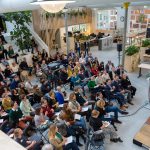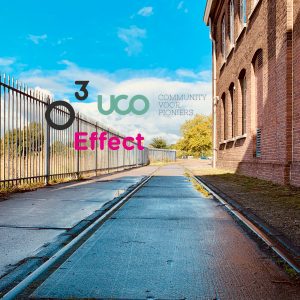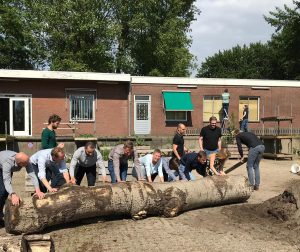
Utrecht Community consists of more than 25 organizations that all contribute to integrated sustainability from their own discipline. In this blogpost, one of UCo’s communitymembers shares its’ knowledge and ideas on a specific topic.
Written by: Except Integrated Sustainability
In this article, we get curious about the divergence between science and practice. Particularly, we focus on what hinders the implementation of theory in the field of sustainability. Herein, we aim to shine a light on how you can use science as the basis for a shift in your organization, what might hinder that process, and how integrated sustainability theories such as Symbiosis in Development can bridge these gaps.
What stops the science of sustainability being used in practice?
Although scientific understanding has been implemented in practice since the beginning of civilization, sustainability is a relatively new field. As such, there is often a separation in decision makers’ understanding of sustainability and the common trends or topics within the scientific community. As the sector grows, it has been often seen that this separation acts as a barrier to an organization’s sustainable transition. The following are three trends which we have encountered throughout 20 years of helping forward looking organizations lay the foundations of a sustainable future. By taking these issues into account when designing an organizational transition, decision makers will be further equipped to convert scientific knowledge in practice.
1. Complexity Translation
“Scientific knowledge itself is often slow to permeate so it takes roughly ten years before scientific knowledge gets used in practice,” said Gertjan van Hardeveld, Except’s Business Strategist.
Understanding and communicating complexity is a prerequisite for sustainable design. “Science is often presented in complex models with interlaced with jargon which hinders the translation aspect of it,” says Gertjan. Often, this holds organizations back from making progress on their sustainability goals; you can’t solve a problem that you don’t understand.
Communicating the proven scientific benefits of a sustainable transition to a decision maker is one of the biggest issues we face as an organization. What we have found is that hyper-localization and benefit context are key to turning complex science into digestible issues which can prompt action. In other words; in order to successfully secure momentum for change, it is important to define the parameters within which you will work (local, regional, national, international), and then how the action will benefit the organization.
“Complexity translation is an important factor within the ten year adoption period, as science becomes more understandable for practitioners, so to can they integrate it into their own developments more efficiently. I believe that transparency in an overflow of information would help narrow this gap a lot,” said Gertjan.
2. Sustainability Literacy
What defines sustainability literacy is a complexity in itself and is precisely the issue. There is a lack of centralised definitions and concepts. “What do we even mean by sustainability?” says Freek van der Pluijm. “The fact that there is no definition for sustainability is a very familiar, well known subject to a lot of people.”
Freek argues that in driving change in an organization, it is as important to boost the bottom line of sustainability literacy – bringing together a common definition to work towards – as it is to implement the latest scientific findings. By building even a simple consensus of sustainability from within the framework of the organization, it is much easier to then promote action.
“The actions that you take that will actually contribute to a more sustainable society don’t have to be based on the newest insights, but rather it has to do with growing the awareness of basic insights. I think there is a lot of ground that can be covered in the short term that doesn’t need such rigorous scientific developments. It’s just about increasing literacy,” he says.
3. Lack of Common Language
For Except Director, Tom Bosschaert the third issue that commonly arises which prevents clients implementing the science of sustainability in practice is the fragmented way in which information is shared. The divergence between concepts within the sustainability world (the circular economy, cradle to cradle, industrial ecology) which serve as a similar purpose point towards a lack of a common language.
Compiling a centralized and transparent database of information that backs up actions with scientific research helps align organizations. “There is a huge gap in knowledge [from theoretical to applied] when talking about a whole lot of new topics. And that’s what’s holding us back,” says Tom.
Without a shared consensus on facts, Tom argues that it is far more difficult to get everyone to align. “Getting the budgets in the first place, getting all the people together, and having everyone on the same page starts with unquestionable scientific research.” Without bringing together the science from one or multiple credible sources as a given, moving forward on a project is incredibly difficult.
Translating Science into Practice
Whilst there is no magic solution, there are a few plausible actions which can increase science’s ability to be utilized in practice. “Using a methodology like Symbiosis in Development helps us to dissect an issue and bridge the gap,” says Tom.
“True sustainable development challenges all aspects of planning and development, from its inception to its strategy, design, and execution. SiD ties together these phases, and connects them with deep scientific sustainability frameworks, innovation tools, and co-creation processes. This helps to create oversight, reduces time, helps find better solutions, and organizes the process.”
“Sustainability is a broad, complex, and dynamic subject, of which many things are yet unknown. We lack educational resources, there’s few people with deep knowledge and experience on the subject, and we lack a universal language. SiD helps to create that language, and allows teams to travel down a pathway with an integrated, full spectrum perspective, ensuring important considerations are not left out. This pathway in itself helps translate complexity, increase literacy, and binds information to a central backbone of a process.”






No comment yet, add your voice below!